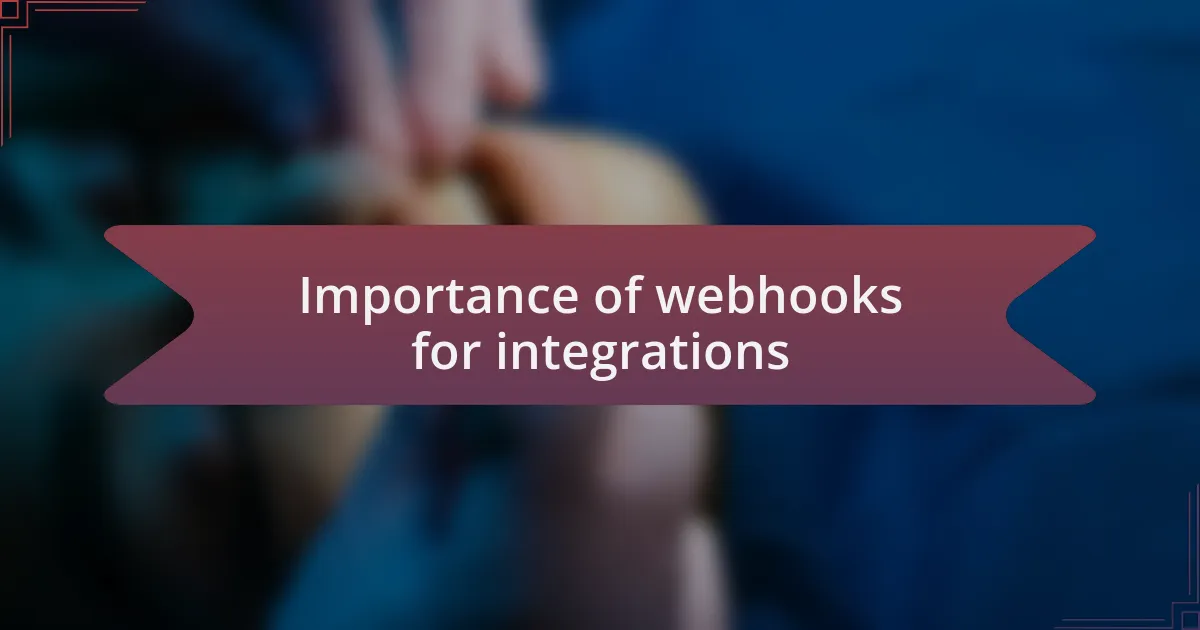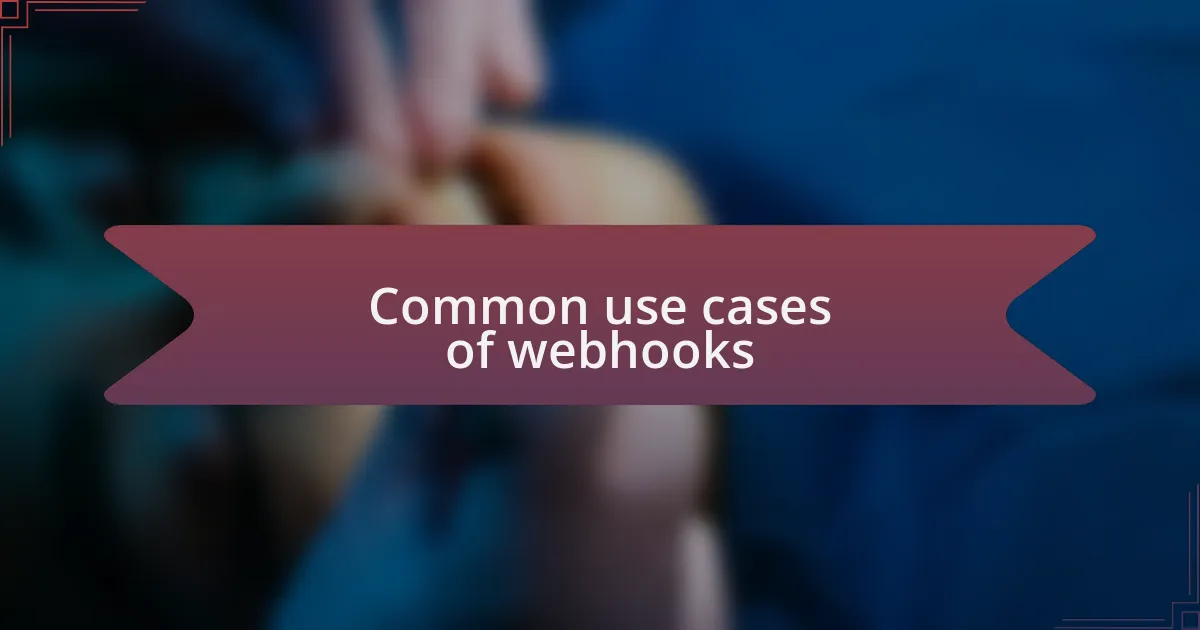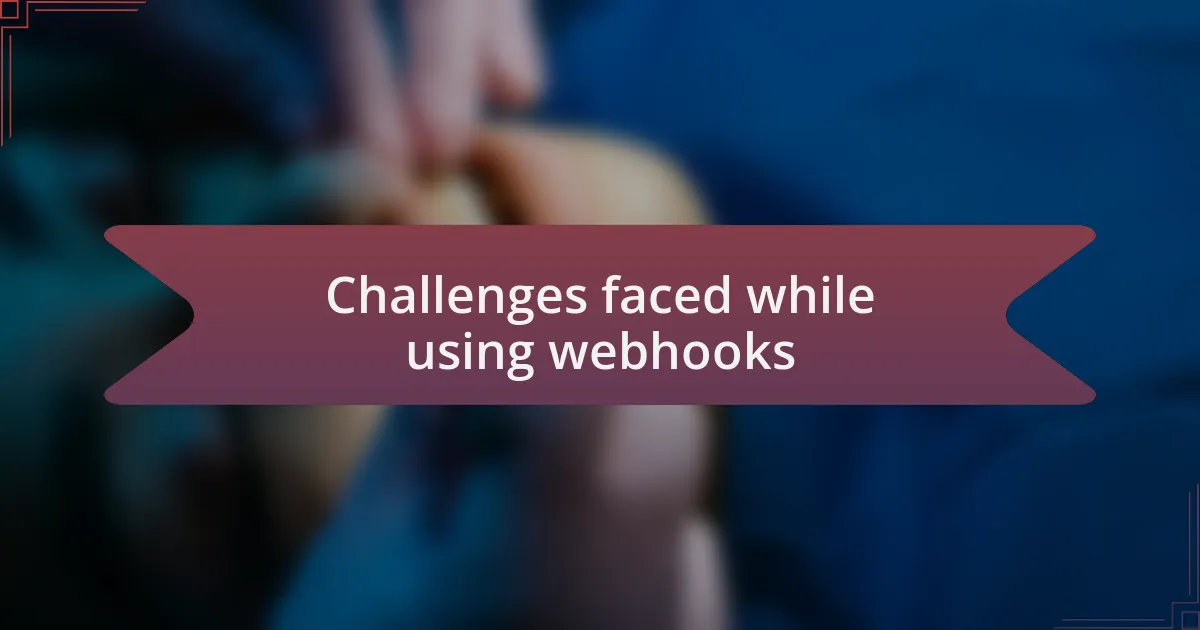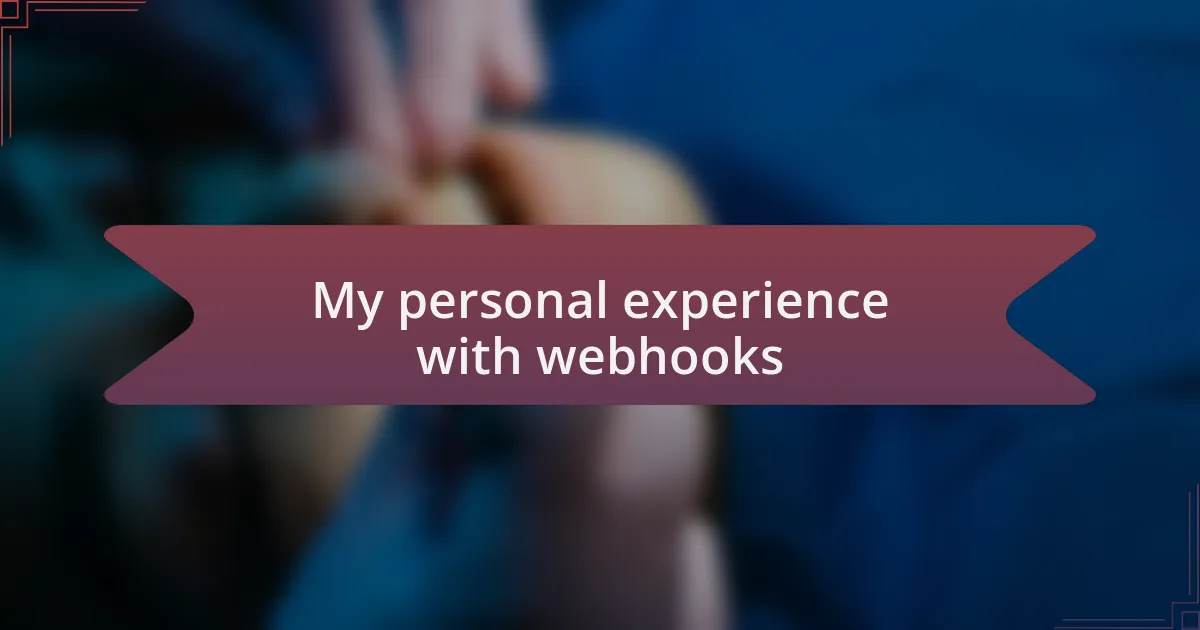Key takeaways:
- Webhooks enable real-time communication and automation between systems, drastically reducing manual work and the risk of human error.
- Proper setup, including defining event triggers and implementing security measures, is crucial for effective webhook functionality.
- Common use cases for webhooks include e-commerce inventory updates, messaging notifications, and CI/CD pipelines, enhancing operational efficiency and user experience.
- Challenges such as handling failures, data format inconsistencies, and debugging can be mitigated through thorough testing, clear documentation, and robust error handling mechanisms.

Understanding webhooks in software development
Webhooks are a powerful tool that can dramatically enhance the way applications communicate with each other. I remember the first time I implemented a webhook—I felt a surge of excitement when I saw real-time data updates flowing seamlessly between systems. It’s almost like watching a live feed of events, where every trigger leads to an immediate action, making interactions feel more dynamic and responsive.
Understanding webhooks involves grasping their fundamental purpose: they allow one system to send data to another whenever a specific event occurs. For example, when a user signs up on your website, a webhook can automatically notify your CRM system to create a new entry. Have you ever considered how much time that saves? In my experience, automating these processes has not only reduced manual work but also minimized the chances of human error.
However, it’s crucial to set up webhooks properly to ensure they function as intended. I’ve encountered challenges where failed webhook calls went unnoticed, causing a domino effect of missed updates. That’s when I learned the importance of implementing proper error handling and logging mechanisms. By doing so, you can create a more robust system that responds to failures and keeps your workflow uninterrupted.

Importance of webhooks for integrations
Webhooks play a critical role in facilitating seamless integrations between disparate systems. I vividly recall a project where I integrated a payment gateway with an ERP system using webhooks, and it was a game changer. With instantaneous notifications for transaction statuses, the entire order management process became smoother, allowing teams to focus on what truly matters—providing value to customers.
What truly strikes me about webhooks is their ability to enhance real-time communication. Imagine a scenario where a user updates their profile; without webhooks, those changes could take ages to reflect across different platforms. In my experience, implementing webhooks drastically cut down on lag time, creating a more engaging user experience and ensuring that teams had access to up-to-date information without the hassle of manual syncs.
The impact of effective webhook integration is profound. I’ve seen organizations drastically improve their operational efficiency by leveraging this technology. Can you picture how much you could save in terms of time and resources? It’s exhilarating to witness teams react to events in real time—it’s like having a pulse on your operations—and it definitely translates to enhanced productivity and collaboration across departments.

Common use cases of webhooks
When discussing common use cases of webhooks, one powerful application that comes to mind is in e-commerce. For instance, I remember implementing webhooks to notify my inventory system when a purchase was made. This setup automatically updated stock levels without manual intervention, making inventory management much more efficient and reducing the risk of selling out-of-stock items. Who wouldn’t feel relieved knowing their systems are synchronized effortlessly?
Another prevalent use is in messaging applications. I fondly recall a project where we integrated webhooks to trigger alerts for new messages or user activities in real time. It was incredible to see how active users could stay engaged without missing important notifications, enhancing the overall user experience. Isn’t it remarkable how timely communication can significantly elevate user satisfaction?
Webhooks also shine in CI/CD (Continuous Integration/Continuous Deployment) pipelines. I had the chance to set up webhooks that automatically triggered builds and deployments whenever code was pushed to the repository. This streamlined our workflow and allowed development teams to release features faster, which is exhilarating, right? Speed and efficiency aren’t just goals; they became part of our day-to-day reality, bringing a sense of accomplishment with leaner operations.

Steps to implement webhooks effectively
To effectively implement webhooks, the first step is to clearly define the event triggers. In my experience, pinpointing the specific user actions that should initiate a webhook is crucial. For instance, during a project for a subscription service, I realized that setting webhooks for events like subscription renewals and cancellations helped us minimize user churn. Have you ever considered how clearly defined triggers can streamline user interactions?
Next, I found it invaluable to establish a secure endpoint for receiving the webhook data. I learned this the hard way after facing security issues in one project, where inadequate authentication exposed sensitive information. Making sure that the endpoint validates incoming requests is essential; I often implement HMAC (Hash-based Message Authentication Code) signatures to ensure that only authorized sources can send data. This kind of diligence not only protects the data but also fosters trust among users.
Lastly, monitoring and logging webhook events is something I can’t stress enough. I recall an instance where I didn’t log incoming webhook actions in detail, which led to a frustrating debugging session. By setting up comprehensive logging, you can trace issues back to their roots quickly and ensure that the entire process works smoothly. Have you ever had a moment where you wished you had better visibility into your systems? Robust logging provides that clarity, turning potential chaos into manageable data streams.

Challenges faced while using webhooks
When using webhooks, one significant challenge I’ve encountered is handling failures and retries. There was a project where a third-party service failed to deliver webhook notifications due to their own downtime. I remember the sense of urgency and frustration as I scrambled to identify the issue. How do you think you’d react in that situation? I realized that implementing a robust retry mechanism could have saved us from losing valuable data and ensured a smoother operation.
Another hurdle I faced is the inconsistency of data formats. In one instance, a partner’s webhook included unexpected payload structures, which caused our processing logic to break down. I felt a mix of disappointment and confusion as I tried to figure out why our system wasn’t behaving as expected. Isn’t it frustrating when you assume everything is in order only to discover that a small detail can cause chaos? To mitigate this, I now establish clear API documentation and perform thorough testing before going live to ensure alignment across systems.
Lastly, I often find that debugging webhook issues can be a real headache. I recall a particularly gnarly problem where events were being processed, but results were nowhere to be found. I stared at logs for hours, piecing together fragments of information. It made me realize how critical it is to have well-defined error handling and alerts in place. Have you ever wished for a magic wand to make debugging easier? Learning to anticipate common pitfalls has not only saved me time but also provided a clearer path through the complexities of webhook integration.

My personal experience with webhooks
My experiments with webhooks have been quite a journey. I remember integrating them for the first time in a client project. The initial excitement quickly turned to anxiety when I realized that testing them in a real-world scenario was nothing like the controlled development environment. Have you ever felt that rush of adrenaline when everything hinges on a newly deployed feature? I definitely did; it was a mix of hope and dread.
One memorable moment was when I set up a webhook to trigger notifications for user actions on a platform. The day we launched, I watched the console for any signs of issues. When the first notification hit, I felt an overwhelming sense of accomplishment. Yet, moments later, I discovered that a small misconfiguration meant some users never received their notifications. That realization was gut-wrenching. I learned the hard way how critical it is to double-check event endpoints and ensure everything’s in sync before going live.
Over time, I found that building a solid foundation for webhook handling involved more than just connecting endpoints. It required anticipating edge cases and understanding user behavior. Once, during a major update, I had to scramble to adjust my webhook handling logic after noticing several users with unique use cases that I hadn’t accounted for. What did this teach me? Adaptability is vital in software development. Embracing the unexpected has made my webhook integrations not just functional, but truly resilient.

Tips for optimizing webhook implementation
To optimize webhook implementation, always prioritize thorough testing in various scenarios before going live. I vividly recall when a colleague suggested simulating high traffic loads. That exercise unveiled performance bottlenecks I hadn’t previously noticed, underscoring just how vital it is to preemptively identify potential issues.
Another tip involves incorporating rate limiting to prevent overload on the receiving server. I faced a situation where a poorly-throttled webhook led to server crashes during a promotional event. Pouring over logs afterwards, it was evident that my initial excitement about high user engagement blinded me to the need for safeguards. I learned that maintaining control over request volume not only protects the server but also ensures a smoother experience for users.
Finally, implementing a retry mechanism is essential when dealing with transient errors. One night, I had a sinking feeling when I found out that undelivered webhooks were lost due to temporary connectivity issues. Motivated by that frustrating experience, I introduced exponential backoff strategies in my code. This adjustment significantly improved the reliability of data delivery and boosted my confidence that no critical event would slip through the cracks unnoticed. How have you addressed similar situations in your own work?